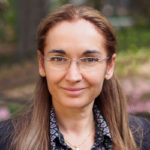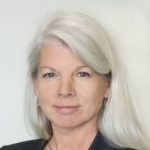Several Biosciences Area personnel have been named as recipients of 2016 Berkeley Lab Director’s Awards. Yan Liang (Biological Systems & Engineering), Eva Nogales, and William Jagust (Molecular Biophysics & Integrated Bioimaging, MBIB) were honored with individual awards in Early Career, Scientific Achievement, and Societal Impact, respectively. Jill Fuss and Steven Yannone (MBIB) were the recipients of a team award in Technology Transfer for the launch of their company CinderBio. Jim Bristow (Biosciences Area Office, Trent Northen (Environmental Genomics & Systems Biology & Joint Genome Institute, JGI), and Susannah Tringe (JGI), along with Eoin Brodie and Peter Nico of the Earth and Environmental Sciences Area, were named in a team award in Service.
PNAS Profile on Nogales Accompanies Inaugural Article
Eva Nogales’ life and research work was highlighted in the PNAS Profile of August 12. The profile, written in recognition of her election to the National Academy of Sciences in 2015, accompanied the PNAS Inaugural Article of Nogales, a faculty structural biologist in the Molecular Biophysics & Integrated Bioimaging Division. In this article, titled “Near-atomic cryo-EM structure of PRC1 bound to the microtubule,” she uses cryo-EM to visualize, at a near-atomic level, how an essential component of the mitotic spindle maintains critical contact with microtubules to aid cell division.
Maxon Presents to Cellular Agriculture Pioneers
On July 14, Biosciences Principal Deputy Mary Maxon participated in the invitation-only Cellular Agriculture Innovators’ Workshop of New Harvest, a non-profit research institute with the mission of building and establishing the field of cellular agriculture. Maxon presented on public-private partnerships and pre-competitive collaborations for the advancement of the field, specifically looking at government programs that could assist in moving it forward.
Biosciences Technology Among R&D 100 Award Finalists
A technology developed by Diane Bryant and Simon Morton, of the Molecular Biophysics & Integrated Bioimaging Division, has been named a 2016 R&D 100 Award finalist. The Compact Dynamic Beamstop (CDBS), a compact, customizable tool for X-ray scattering experiments providing real-time data, is one of seven Berkeley Lab technologies plus one multi-lab nomination including the Lab that made the list of finalists.
Widely recognized in industry, government, and academia as a mark of excellence for the most innovative ideas of the year, the R&D 100 Awards are the only industry-wide competition rewarding the practical applications of science. They recognize the most promising new products, processes, materials, or software developed throughout the world and introduced to the market the previous year. This year’s 100 award winners will be announced in November.
How Does a Bird Know What’s Coming Next?
Bengalese finches, songbirds that have been used to research the learning, perception, and production of bird song, are the model system used by Berkeley Lab scientist Kristofer Bouchard and Michael Brainard of UC San Francisco to determine the relationship between song sequence structure and brain activity. As reported in their PNAS article published last week, “Auditory-induced neural dynamics in sensory-motor circuitry predict learned temporal and sequential statistics of birdsong,” the researchers studied how the birds brain forms predictions for the timing and identity of specific “syllables” that it has learned to sing.
- « Previous Page
- 1
- …
- 6
- 7
- 8
- 9
- 10
- 11
- Next Page »
Was this page useful?








